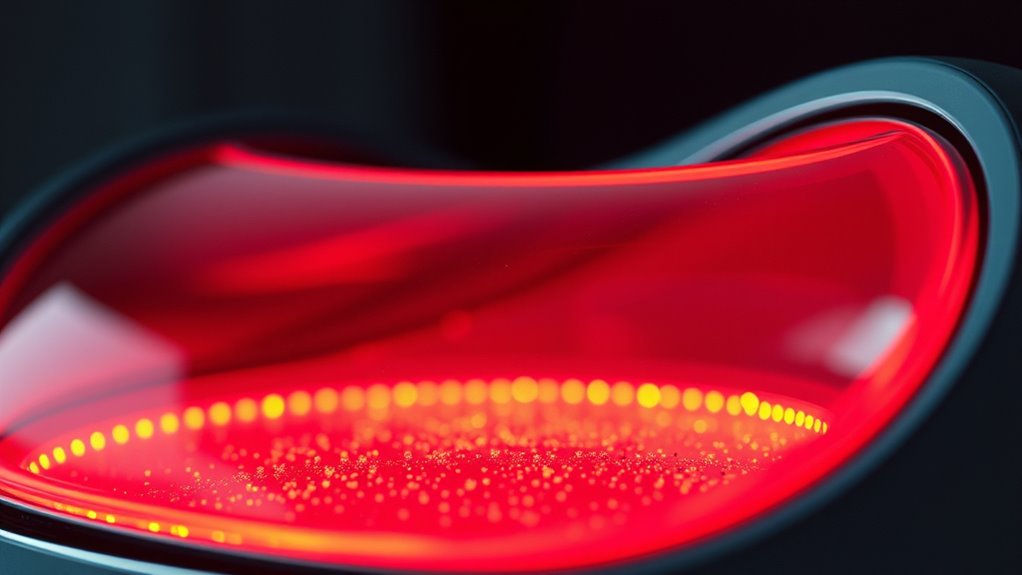Red light therapy penetrates deep into your tissues, stimulating mitochondria to produce more ATP, which supplies cells with extra energy to repair and reduce inflammation. It also boosts antioxidants, helping neutralize free radicals that cause cell damage. By modulating immune responses and promoting tissue regeneration, red light therapy decreases inflammation and speeds recovery. This safe, non-invasive approach supports overall tissue health. To understand the detailed science behind its anti-inflammatory effects, explore further insights here.
Key Takeaways
- Red light penetrates deep tissues, stimulating mitochondria to produce more ATP, which enhances cellular repair and reduces inflammation.
- It boosts antioxidants in cells, neutralizing free radicals that cause oxidative stress and tissue damage.
- Red light promotes the release of anti-inflammatory molecules, calming immune responses and supporting tissue healing.
- It encourages regeneration of damaged tissues and improves circulation, delivering nutrients and removing waste for faster recovery.
- By improving mitochondrial function and reducing oxidative stress, red light helps balance inflammation and promotes overall tissue health.

Red light therapy has gained popularity for its ability to reduce inflammation, but understanding how it works requires a look at the science behind it. When you shine red or near-infrared light on your skin, it penetrates deep into your cells, triggering a process called cellular repair. This process involves stimulating your mitochondria, the energy producers within your cells, to produce more adenosine triphosphate (ATP). With increased ATP, your cells have more energy to repair damage and restore normal function, which can help reduce inflammation and promote healing.
Red light therapy stimulates cellular repair by boosting mitochondrial ATP production, aiding inflammation reduction and healing.
One key aspect of how red light therapy reduces inflammation is its impact on oxidative stress. Oxidative stress occurs when harmful molecules called free radicals build up in your body faster than your natural antioxidant defenses can neutralize them. This imbalance damages cells, tissues, and DNA, fueling inflammation and slowing healing. Red light therapy helps counteract oxidative stress by boosting the production of antioxidants within your cells. These antioxidants act like scavengers, neutralizing free radicals and preventing further damage. As a result, your body’s natural ability to manage oxidative stress improves, leading to a reduction in inflammation.
Additionally, red light therapy influences cellular signaling pathways that regulate inflammatory responses. By stimulating your cells, it prompts the release of anti-inflammatory molecules, which help calm the immune system’s overreaction. This modulation of inflammation is vital for tissue repair and pain relief, especially in chronic conditions.
Your body’s response to red light isn’t just about immediate relief; it promotes long-term healing by encouraging the regeneration of damaged tissues. The enhanced cellular repair process supports the rebuilding of healthy cells and tissues, helping you recover faster from injuries or inflammatory conditions. This regenerative effect is partly due to the increased circulation that red light therapy encourages, bringing more oxygen and nutrients to affected areas and flushing out waste products.
Furthermore, research indicates that red light therapy can influence mitochondrial function, leading to improved energy production at the cellular level. In essence, red light therapy harnesses the power of light to kick-start cellular repair mechanisms, reduce oxidative stress, and balance inflammatory responses. This combination of effects makes it a promising non-invasive treatment for managing inflammation and supporting overall tissue health. As research continues, you’ll find more evidence that targeted light therapy can be an effective tool in your health and wellness routine, especially when it comes to managing inflammation and accelerating recovery.
Frequently Asked Questions
Can Red Light Therapy Treat Chronic Inflammation Conditions?
Red light therapy can effectively treat chronic inflammation by leveraging its red light mechanism. When you use red light, it penetrates your skin, promoting cellular repair and reducing inflammation. Many people find relief from chronic inflammation conditions like arthritis or tendonitis with consistent treatments. While results vary, red light therapy offers a non-invasive, drug-free option that targets inflammation at the cellular level, helping you feel better and move more comfortably.
What Are the Potential Side Effects of Red Light Treatment?
While red light therapy is generally considered safe, it’s wise to be aware of potential safety concerns. You might experience mild skin redness, temporary discomfort, or eye sensitivity if not properly protected. Keep in mind treatment limitations, as overuse or improper application can diminish effectiveness. Always consult a professional to ensure safe, tailored use, and avoid any unintended side effects that could arise from misapplication.
How Does Red Light Compare to Traditional Anti-Inflammatory Medications?
Red light therapy offers a natural alternative to traditional anti-inflammatory medications, which often come with side effects. You might find it less invasive and easier to use regularly. While the initial cost can be higher, it may save you money long-term by reducing reliance on medications. Compared to drugs, red light provides a safer, non-pharmaceutical option, making it a compelling choice for managing inflammation naturally.
Is Red Light Therapy Effective for All Skin Types?
Did you know that red light therapy is effective for over 90% of skin types? You’ll find it offers great skin compatibility, making it appropriate for most individuals. However, treatment customization is key, as some skin sensitivities may require adjusted settings. Always consult a professional to make sure the therapy suits your specific skin type and needs, maximizing benefits while minimizing any potential irritation.
How Long Does It Take to See Results From Red Light Therapy?
You might start seeing results from red light therapy after about 4 to 6 weeks, but treatment duration varies depending on your individual response. Some people notice improvements sooner, while others may need longer. Consistency is key, so sticking to your schedule helps optimize outcomes. Keep in mind that factors like skin type, condition severity, and overall health influence how quickly you see benefits.
Conclusion
Now that you understand how red light therapy works to reduce inflammation, it’s clear this isn’t just a passing fad. By tapping into your body’s natural healing processes, you can gain a powerful ally in wellness. Just remember, Rome wasn’t built in a day—patience and consistency are key. Embrace this science-backed approach, and you might find yourself turning over a new leaf in managing inflammation and improving overall health.









